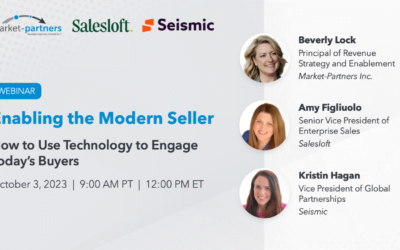Last week, Market-Partners Inc. Principal and Founder, Martyn Lewis, presented again at SAMA’s Annual Conference. The two-and-a-half-day event was packed with though-provoking presentations, breakout sessions, and corridor conversations. Thank you to the organizers for all their hard work, as well as to the old faces and new friends we had the pleasure of speaking to in New Orleans.
Martyn presented alongside cohost Deb Honea of AWS on Managing the Hidden Buying Journey. Whether you couldn’t make our session or are simply looking for a refresher, we wanted to provide you with a quick summary and some actionable insights from our part of the conference.
Managing the Hidden Buying Journey
Our research shows that salespeople are involved in less than 10% of their customer’s buying activities – yet 100% of these activities can and will affect how likely a customer is to make a purchase. Leaving so much of your customer’s buying process in the dark is the most frequent cause of “buying journeys to nowhere.” This is a critical situation where the salesperson has forecasted the sale, believing their champion is taking things from there; but in reality, the champion is getting hung up on resistance from within their organization, about to decide the seller’s offering is not worth the effort.
The truth is your customer is probably going through this journey for the very first time, having never purchased your offering before. This means your champion can easily be caught off guard when unexpected players come out of the woodwork with objections they don’t have the answers to. As sellers though, we have hopefully seen successful purchases in the past, making us acutely aware of the roadblocks and how and when they occur. Because of this, we are in the perfect position to be proactive – anticipating objections and either resolving, mitigating, or navigating prospects away from friction.
This is why strategic account management and mapping the buying journey go hand in hand. When we map the buying journey, we can see what will happen in the buying process ahead of time: who will get involved, what they care about, and what the concerns will be. And because these patterns are predictable across a specific market, this means we can manage these journeys and operationalize around how our customers buy.
A Key Moment from Our Session
One exercise that resonated with our audiences in New Orleans was asking members to put themselves in their customers shoes. Most of businesspeople have been involved in a corporate purchase at some point, maybe even been the champion themselves. So, think back – what happened the last time your organization bought something?
The shared experience among attendees was that there were many, many people to convince in order to progress the deal, and that the list only grew as more and more players began to stick their oar in. Upon asking when these additional players got involved, the response was always, “At the very end” – to which there were audible laughs of agreement.
Bringing Buying Journeys into the Light
When an organization is considering any kind of large-scale offering, most employees and departments assume the proposal is going to die like a majority of them do. So, it is only when the sale is starting to look possible that coworkers and stakeholders choose to object. Is this brand the right fit for our business? How will this affect existing systems? Why is this initiative more important than what I am doing? Suddenly, objections both big and small begin to pile up.
While late-stage opportunity crash and burn remains an all-too-common problem, it doesn’t have to if a seller has properly mapped the buying journey. These well-equipped salespeople can work with their champions to incorporate key players earlier in the journey, managing them more directly. This not only shortens the overall buying process but massively increases the chance of a successful purchase.
Want to put this into action? Next time you are speaking with a prospect, make a mental note of the steps they are taking and the challenges they will soon face based on your previous sales. Instead of focusing on the “selling” itself, help your customer navigate their buying journey; prepare for any upcoming friction with the proper tools, information, and knowledge to help bypass it as effectively as possible. And voila, the journey has already started to be revealed!




